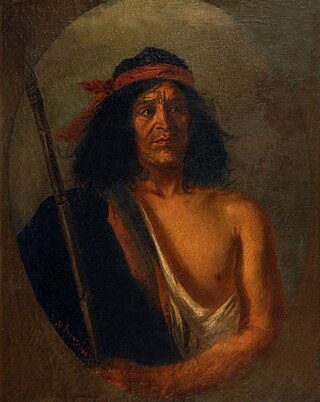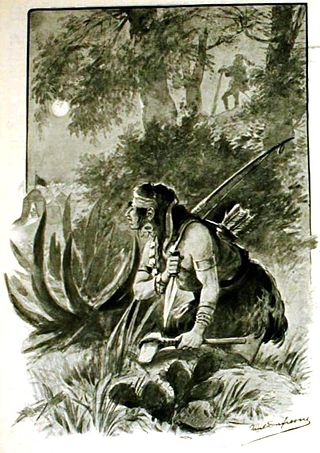
Caupolicán was a toqui or war leader of the Mapuche people, who led the resistance of his people against the Spanish Conquistadors who invaded the territory of today's Chile during the sixteenth century. His rule as Toqui lasted roughly from 1553-1558 AD.

Toqui is a title conferred by the Mapuche on those chosen as leaders during times of war. The toqui is chosen in an assembly or parliament (coyag) of the chieftains (loncos) of various clans (Rehues) or confederation of clans (Aillarehues), allied during the war at hand. The toqui commanded strict obedience of all the warriors and their loncos during the war, would organize them into units and appoint leaders over them. This command would continue until the toqui was killed, abdicated (Cayancaru), was deposed in another parliament, or upon completion of the war for which he was chosen.

A lonko or lonco, is a chief of several Mapuche communities. These were often ulmen, the wealthier men in the lof. In wartime, lonkos of the various local rehue or the larger aillarehue would gather in a koyag or parliament and would elect a toqui to lead the warriors in battle. Lonco sometimes forms part of geographical names such as the city of Loncoche.

Pelantaro or Pelantarú was one of the vice toquis of Paillamachu, the toqui or military leader of the Mapuche people during the Mapuche uprising in 1598. Pelantaro and his lieutenants Anganamon and Guaiquimilla were credited with the death of the second Spanish Governor of Chile, Martín García Óñez de Loyola, during the Battle of Curalaba on December 21, 1598.
Ulmen is a Mapudungun word meaning "rich man". In Mapuche society, the wealthy men were usually the loncos and would often be the influential leaders of their rehue and aillarehue. If skilled in war, like the military leader Caupolicán, they were sometimes elected toqui.
Caupolicán the Younger according to Juan Ignacio Molina was the son of the toqui Caupolicán. He was made toqui following the capture and execution of his father in 1558. He continued the first Mapuche rising against the Spanish conquistadors in 1558 and commanded the Mapuche army in constructing a pukara at Quiapo to block García Hurtado de Mendoza from rebuilding a fort in Arauco completing the chain of forts for suppression of their rebellion. In the Battle of Quiapo the Mapuche suffered a terrible defeat and there Caupolicán the younger died. His successor as toqui was Illangulién.
Cadeguala or Cadiguala was a Mapuche toqui elected in 1585 following the death in battle of the previous toqui Nangoniel. Cadeguala was a noted warrior and the first Mapuche toqui known to have used cavalry successfully in battle. He was killed in a duel with the garrison commander of the Spanish fort at Purén in 1586.
Paineñamcu or Paynenancu or Alonso Diaz, was the Mapuche toqui from 1574 to 1584. Alonso Diaz was a mestizo Spanish soldier offended because the Governor of Chile did not promote him to the officer rank of alféres, who subsequently went over to the Mapuche in 1572. He took the Mapuche name of Paineñamcu and because of his military skills was elected toqui in 1574 following the death of Paillataru.
Nangoniel was the Mapuche Toqui in 1585, and son of the previous toqui Cayancaru. He was the first Toqui to use cavalry with the Mapuche army.

Lientur was the Mapuche toqui from 1618 to 1625. He was the successor to Loncothegua. Lientur with his vice toqui Levipillan was famed for his rapid malóns or raids. Because of his ability to slip back and forth over the Spanish border between its fortresses and patrols and raid deep into Spanish territory north of the Bio-Bio River without losses he was called the Wizard by the Spanish.
Pilmaiquén or Pilmayquen is a riachuelo in the commune of Cañete in Arauco Province in the Bío Bío Region of Chile that flows southwest towards the coast of the Pacific Ocean, to the northwest of the city of Cañete. Its course is short but of great volume and traverses a small valley between wooded mountainous areas where it joins the Licauquén River. This valley was a Moluche rehue of the Tucapel aillarehue and the homeland of the Toqui Caupolicán who commanded the Mapuche in the first revolt against domination by the Spanish Empire.
Guanoalca was the Mapuche toqui (leader) elected in 1586 following the death in battle of the previous toqui, Cadeguala, killed in a duel with the garrison commander of the Spanish fort at Purén in 1586. He returned to continue the siege and forced the Spanish to evacuate the fort, which he then destroyed.
Paillaeco was elected Toqui in 1592 in place of Quintuguenu after Quintuguenu's defeat and death. Paillaeco did not think his forces were now sufficient to oppose the Spanish in the open field and decided to draw them into an ambush. The Spanish turned the tables on them drawing his army out of their ambush and destroyed it killing Paillaeco. Paillamachu was elected to succeed him later the same year 1592.
Huenecura or Huenencura was the Mapuche Toqui from 1604 to 1610. He replaced Paillamachu who died in 1603. He was replaced by Aillavilu in 1610.
The Mapuche were a bellic culture, and their history was plagued by wars and conflicts since they began to settle in the Araucanía; they believed that history was created through warfare, and thus engaged in many military conflicts.
The Parliament of Malloco was held between governor Juan Henríquez de Villalobos and leaders of the Mapuche in January 1671, at Malloco southwest of Santiago, Chile.
Butapichón or Butapichún or Putapichon was the Mapuche toqui from 1625 to 1631, as successor to Lientur. After the death of Quepuantú in 1632 he became toqui once again from 1632 to 1634.
El Toqui mine is a zinc-gold mine in Chile. Besides silver and lead are also mined in El Toqui. The mine is owned by Breakwater Resources through its wholly owned subsidiary company Sociedad Contractual Minera el Toqui. The mine was purchased from Barrick Gold Corporation in 1997.
Paillamachu, was the Mapuche toqui from 1592 to 1603 in what is now Chile.
Quepuantú was an indigenous Chilean Moluche toqui in the 17th century. He was known for his leadership in the Arauco War and succeeded Butapichón in commanded the Mapuche army against the Spanish as Toqui, from 1631 to 1632. On January 13, 1631 he commanded the Mapuche army with Butapichón against Spanish forces led by the very competent Governor Francisco Laso de la Vega who defeated them in the pitched battle of La Albarrada. He died in 1632 in a duel with the cacique Loncomilla, his rival for dominance in the command of his tribe. Butapichón succeeded him as Toqui for a second time from 1632 to 1634.
This page is based on this
Wikipedia article Text is available under the
CC BY-SA 4.0 license; additional terms may apply.
Images, videos and audio are available under their respective licenses.




